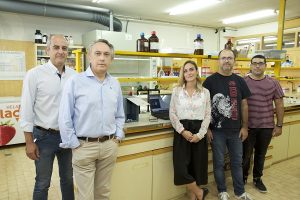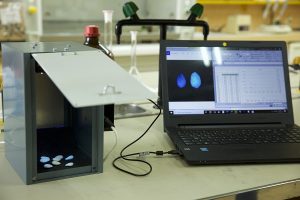
دستگاه جدا کردن بادام تلخ
درخت بادام از تنوع ژنتیکی بالایی برخوردار است و متاسفانه وجود ارقام تلخ در میان بادام های شیرین، تاثیر زیادی در میزان استقبال مشتری از بادام و در نتیجه بازار این محصول کشاورزی دارد. از این رو خالص بودن بادام شیرین هم برای تولیدکنندگان بادام، و هم برای صنایع غذایی که از بادام در شیرینی و شکلات و بستنی استفاده می کنند از اهمیت بسیار بالایی برخوردار است. در حال حاضر آمریکا با تولید بیش از 80% از بادام جهان، بزرگترین تولیدکننده بادام است و کشورهای استرالیا و اسپانیا و ایران از تولیدکنندگان مهم دیگر هستند. اما بادام آمریکایی بر خلاف این که تلخی ندارد و کاملاً شیرین است، از نظر طعم و بو و بافت به پای سایر بادام ها نمی رسد.

محققین دانشگاه الیکانت اسپانیا، موفق به اختراع دستگاهی برای شناسایی بادام تلخ شدند. این دستگاه جدا کردن بادام تلخ توسط گروه طیف سنجی اتمی تحلیلی در دانشگاه الیکانت اسپانیا به سرپرستی پروفسور خوان پاستور، بر اساس پردازش تصویر دیجیتال، امکان شناسایی و دسته بندی خودکار مغز بادام های تلخ و شیرین را با سرعت و دقت فراهم می کند. شاید مهمترین ویژگی این روش، آسیب نرساندن به خواص فیزیکی و شیمیایی و تغذیه ای بادام است که آن را به عنوان روشی دوستدار محیط زیست و تغذیه سالم مطرح می کند. در این دستگاه از هیچ معرف شیمیایی استفاده نمی شود و هیچ ضایعاتی تولید نمی شود، همچنین بدون نیاز به آموزش خاصی توسط هر کاربر قابل اجراست.
اساس کار دستگاه جدا کردن بادام تلخ بر تشعشعات فلورسنس و چشم مصنوعی استوار است. در حقیقت ترکیبات موجود در بادام تلخ تشعشعات فلورسنسی از خود ساتع می کند که با تاباندن طول موج خاصی از نور به بادام، و پردازش تصویر تولید شده قابل شناسایی است. بنابراین بادام های تلخ که غلظت بیشتری از آمیگدالین دارند، از بادام های شیرین جدا خواهند شد.
منبع: پایگاه خبری دانشگاه الیکانت اسپانیا، 18 مهر 1398
University of Alicante Analytical Atomic Spectrometry research group led by Professor of Analytical Chemistry Juan Mora Pastor, has developed a new procedure and device to detect bitter almonds based on digital image processing in real time. As the director of the group pointed out, this is a non-destructive analytical method based on fluorescence and artificial vision to identify bitter almonds. Thus, the basis of the method lies in the fluorescence emitted by the compounds naturally present in bitter almonds. These can be detected specifically only by illuminating the sample with appropriate wavelength light and subsequent processing of the image generated. The method allows researchers to automate the classification of sweet and bitter almonds quickly, simply, objectively and in real time using a cheap, eco-friendly and non-destructive procedure.
There has been no discriminatory, easy and quick method that meets the needs of the industry at any level of the production chain so far. Speed, accuracy, objectivity, simplicity of application, reproducibility and being a non-destructive method that respects the environment are some of its many advantages. Moreover, it does not require the use of chemical reagents and does not generate any type of waste and the method can be used safely by any operator without prior specific training. Additionally, the system allows for automated and online industrial deployment.
The beneficiaries of this technology include almond producers, agri-food cooperatives, nougat companies, ice-cream manufacturers, bakers and pastry makers, as well as suppliers of ingredients that include almonds in their product portfolio.
The technology can be easily implemented industrially, allowing all bitter almonds to be detected unequivocally and is already available to companies interested in its commercial exploitation through the UA Technology & Knowledge Transfer Office.
The almond market
The almond tree has a great genetic variability. Although sweet taste is dominant in almonds, there is still a large presence of bitter almonds in Spanish crops. According to Juan Mora, the problem of the presence of bitter almonds is very frequent in any agricultural production. This presence in manufactured products (nougats, chocolates, etc.) is a serious handicap for the producing companies, which have lacked a quick and simple tool so far. However, in addition to the unpleasant taste, the greatest risk lies in the toxicity of these fruits. The bitter taste of almonds is due to the presence of amygdalin, which, upon contact with the enzyme amylase in saliva, is transformed into benzaldehyde (which confers the bitter taste) and hydrocyanic acid or cyanide, a highly toxic compound.
In terms of world almond production, California holds 80 percent of the market share, followed by Australia, with 8 percent, and Spain, with 5 percent. In this sense, the United States sells almond varieties whose quality is homogeneous and guarantees the total absence of bitter almonds, although their organoleptic characteristics are much lower than Mediterranean varieties.
Spain is a major world importer of almonds and Spanish industry processes them in different ways in order to export them mainly to Germany, France and Italy. The presence of a small percentage of bitter almonds in batches of sweet almonds leads to toxicity and great economic repercussions for producers of almonds and derived products, such as nougat, drinks and vegetable pâtés or flours. Consequently, this causes distrust in the manufacturers of products and by-products containing almonds of Spanish origin.
At present, there is no discriminatory method that meets the needs of the industry, able to be implemented quickly and accurately in production plants. Therefore, the subjective process of random tasting results in massive returns of the product damaging export sales.
The method
The new procedure developed by professors Juan Mora, Luis Gras, Guillermo Grindlay and Marta Navas, all of them from the Department of Analytical Chemistry, Nutrition and Food Science, has been patented by the UA. The technology allows a quick classification of almonds based exclusively on the processing of different parameters of digital images. These are compared with a data storage system previously analysed and processed. This procedure generates and stores discrimination models to automatically differentiate bitter almonds from sweets almonds.
The simple method consists of placing the almonds on a properly illuminated surface. There, the almonds can be dosed by the device automatically or manually, individually or in batches, by means of a hopper or conveyor belt adapted to the line that supplies the almonds in an orderly manner. Once the sample batch has been distributed evenly on the surface by means of conveyor belts or vibrating tables, it is illuminated with an ultraviolet light source. This means that the bitterest almonds can be detected quickly. A simultaneous processing of the digital images retrieved together with a computer application that includes a discrimination model, makes the detection of almonds with higher concentration of amygdalin possible.
The procedure and device has been patented under the name “Procedimiento para la detección de almendras amargas basado en el procesamiento de imágenes digitales y el dispositivo asociado” (Procedure for the detection of bitter almonds based on digital image processing and the associated device) with patent number P201930561.


